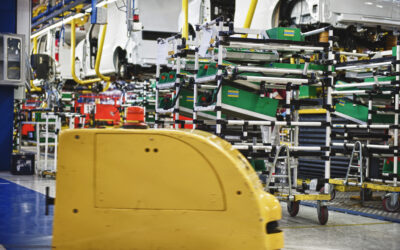When OpenAI publicly released its first large language model (LLM) in November 2022, it ignited a global wave of generative AI adoption that has fundamentally reshaped how technology—and the infrastructure behind it—scales.
From predictive analytics to autonomous design tools, AI applications are consuming unprecedented computing power. Data centers, the physical backbone that supports this digital intelligence, are racing to expand capacity to keep up.
Increasingly modular in design, today’s data centers depend on a vast ecosystem of suppliers. These suppliers provide everything from precision-engineered cooling systems to server racks, cabling, and power backup equipment.
Data Center Suppliers Face Increasing Pressure
As hyperscale and edge facilities multiply across continents, data center suppliers are feeling the squeeze. They’re being asked to deliver faster, more efficiently, and at higher volumes without expanding their footprint or costs proportionally.
The pressure is immense. According to McKinsey, global demand for data center power is projected to reach ~1,400 TWh per year by 2030, meaning the U.S. alone would need to more than triple its annual power capacity just to keep up.
As AI and machine learning workloads surge, the time to market for new capacity is becoming a critical bottleneck. The question is no longer just about how much can be produced, but how fast and efficiently it can be delivered.
That’s where lean manufacturing comes in. By focusing on rapid concept iteration, lead time reduction, and customer value, lean principles empower data center manufacturers and suppliers to scale smarter, boosting throughput without bloating cost, space, or lead times.
Understanding the Data Center Supply Chain and Ecosystem
The data center ecosystem is a highly interconnected network of suppliers that collectively build the infrastructure powering the world’s most advanced digital systems.
From the upstream fabrication of metal frames and cabling to the downstream integration of servers, cooling, and power systems, each node in this supply chain must perform with precision and predictability.
Data center manufacturers face ongoing stress from volatile materials pricing, freight delays, and shifting regulatory landscapes. Upstream suppliers—such as sheet-metal fabricators, cooling system OEMs, and generator vendors—must constantly adapt to design revisions and fluctuating order volumes while keeping operations lean.
Understanding these relationships reveals where optimized material flow and lean principles can create the most impact.
Cooling Units
Cooling systems are among the most vital and resource-intensive components in data centers. These commercial freezer-like units, ranging from closet-sized to van-sized, regulate thermal loads generated by dense racks of servers and networking equipment.
Data centers produce extraordinary amounts of heat that must be continuously managed to ensure uptime and reliability. While traditional air-based cooling remains common, liquid and immersion cooling technologies are rapidly emerging due to their superior efficiency. However, these advances introduce manufacturing complexity: evolving designs, new materials, and even regional water availability constraints.
Many data centers consume millions of gallons of water annually, with hyperscale sites using up to 200 million gallons. This makes sustainable cooling a strategic priority. For cooling system manufacturers, lean solutions help enable flexibility, efficient assembly, and rapid adaptation to new cooling technologies without overextending physical production lines.
Server Racks
Server racks form the skeletal framework of every data center, housing computing, storage, and networking hardware. Their manufacturing demands exceptional precision, often involving tight-tolerance sheet metal fabrication, ergonomic assembly, and rigorous thermal performance validation.
Frequent design iterations, driven by airflow improvements or space optimization, can disrupt standard workflows. Lean principles like modular work cells, point-of-use material storage, and visual management help server rack manufacturers accelerate changeovers and maintain consistent quality, even under compressed timelines.
Cabling
Cabling systems serve as the circulatory system of a data center, carrying both power and data between racks and subsystems. But behind the scenes, cable manufacturers and assemblers face challenges that can disrupt production efficiency: long lead times on copper, specialized insulation materials, and complex code compliance requirements.
Lean improvements—such as pre-configured kitting, ergonomic spooling tools, and dedicated cable routing carts—can reduce waste and worker strain, minimize rework, and improve throughput consistency.
Power Backup Systems
Generators and uninterruptible power supply (UPS) units provide the redundancy that data centers rely on for 24/7 uptime. These are large, complex systems that must meet stringent safety, emissions, and performance standards.
Power system suppliers deal with long certification cycles, bulky component handling, and tight installation schedules. Implementing lean tools—like custom material handling carts, quick-change fixtures, and modular assembly layouts—can dramatically improve flow and reduce handling time.
How Lean Solutions Support Data Center Suppliers
As data centers evolve from megawatt-scale facilities to gigawatt-scale campuses, they require exponential quantities of cooling units, racks, cables, and power systems. Lean manufacturing gives data center suppliers the tools to keep up, enabling faster deployment, safer handling, and better use of space.
Let’s explore how targeted lean solutions directly support their most pressing challenges:
#1. Improved Material Flow
Custom-engineered carts, such as hand-push, pick, dunnage, and tug, enable seamless flow of heavy or high-value materials between workstations.
For data center component manufacturing, efficient material flow means cooling coils, sheet metal panels, or bundled cables move smoothly through assembly, minimizing congestion and reducing the need for forklifts or manual lifting.
#2. Optimized Work Cells
Lean workstations are purpose-built environments that enhance productivity, ergonomics, and adaptability.
For data center suppliers, modular workstations can be tailored for precision assembly of server rack components, cooling modules, or control panels, supporting greater productivity and lower ergonomic strain.
#3. Modular and Scalable Solutions
Modular lean solutions, such as mobile racks, reconfigurable carts, and adjustable pre-assembly fixtures, help facilities scale flexibly as order volumes grow.
These modular systems maximize vertical space and can be reconfigured for new products or process layouts without capital-intensive construction.
#4. Enhanced Operator Ergonomics and Efficiency
Cable handling, rack lifting, and repetitive assembly motions can lead to injury and inefficiency. Lean ergonomics focuses on reducing physical strain through height-adjustable carts, assistive lifts, and proximity-based material presentation.
The result: fewer worker compensation claims, faster cycle times, and improved morale.
#5. Better Visual Management
Flow racks and 5S stations enable visual control of inventory and workflow. Shadowboards, color-coded labeling, and laser-etched part identification allow technicians to instantly locate tools or materials.
For data center suppliers, this translates to fewer errors and faster changeovers during production surges.
#6. Reduced Product Handling
Every touchpoint is an opportunity for damage. Lean product handling systems—like server rack positioning jigs, lift-assist devices, and precision mounting tools—minimize manual manipulation.
This protects high-value equipment and ensures consistent quality during final assembly.
#7. Kitting Solutions for Space Savings
Kitting consolidates all components required for a specific build into one organized, mobile unit. For example, a cooling module kit might include all valves, fasteners, and harnesses needed for assembly.
This approach saves space, shortens pick times, and reduces errors across large or custom product runs.
#8. Streamlined Picking Processes
Efficient picking processes ensure operators can quickly access the right parts at the right time.
Lean-designed pick carts, flow racks, and visual pull systems minimize walking and waiting time, which is essential when building complex assemblies like UPS modules or cable harnesses.
#9. Efficient Inventory Management
In fast-moving supply chains, overstocking and shortages are equally harmful.
Lean inventory systems promote just-in-time (JIT) delivery and digital kanban tracking, giving data center suppliers real-time visibility and control over materials without bloating floor space.
#10. Minimized Lineside Footprint
By staging only necessary materials at the point of use, suppliers can maintain cleaner, safer, and more efficient assembly areas.
Flow racks and replenishment carts ensure parts arrive lineside only when needed, reducing clutter and optimizing available space.
Exploring Lean Layout Principles for Data Center Manufacturers
As AI accelerates infrastructure demand, new assembly lines are often launched in space-constrained facilities. Expanding physical space isn’t always feasible or fast enough. That’s why optimizing existing layouts through lean design is critical.
Geolean’s experts partner with data center manufacturers to develop layouts that balance flow, flexibility, and scalability by:
- Applying U-shaped work cells to minimize travel distance.
- Using value stream mapping to identify bottlenecks and waste.
- Standardizing work and introducing visual controls for consistency.
- Reducing work-in-progress (WIP) to prevent congestion.
- Designing modular subassemblies for efficient pre-build and integration.
- Implementing common subcomponents to streamline multi-product lines.
- Planning incremental, modular expansions instead of disruptive overhauls.
- Using portable stations to rebalance workloads dynamically.
In turn, you’ll benefit from a smarter, faster, and more adaptable production environment ready for the next wave of AI-driven growth.
Tips for Forecasting Demand and Ramping Operations
AI-driven infrastructure is evolving daily. For data center suppliers, scaling operations intelligently requires both accurate forecasting and agile response.
From a lean perspective, here are key strategies to forecast and ramp efficiently:
- Align cross-functionally early. Involve engineering, procurement, and production teams in planning to ensure forecasts reflect both design maturity and supplier readiness.
- Map value streams dynamically. Regularly update material flow maps to visualize potential bottlenecks before they occur.
- Implement flexible capacity buffers. Design modular cells and equipment layouts that can flex up or down quickly without new construction.
- Invest in flow-first automation. Automate where it supports flow and consistency, not just to add technology.
- Track leading indicators. Monitor quote requests, material commitments, and data center permitting trends to anticipate volume shifts.
- Prioritize supplier relationships. Work closely with critical upstream vendors (sheet metal, cabling, cooling systems) to align production capacity with market demand.
By treating lean as both a manufacturing philosophy and a strategic planning framework, data center suppliers can scale confidently in an uncertain, fast-moving environment.
Enabling Data Center Suppliers to Succeed as AI Expands
At Geolean, we understand the unique pressures facing data center manufacturers and suppliers in this new era of exponential AI growth. Whether you need a single ergonomic workstation, a full lean layout redesign, or on-site implementation support, we’re ready to meet you where you are.
Our team provides both custom-engineered structures and ready-to-order standard solutions, designed to improve flow, safety, and scalability. We don’t just build structures; we partner with you to design smarter systems, accelerate throughput, and continuously improve your operation.
The AI revolution is here. Let’s make sure your manufacturing systems are ready for it.
Contact Geolean today to discuss your needs or request a customized quote.



